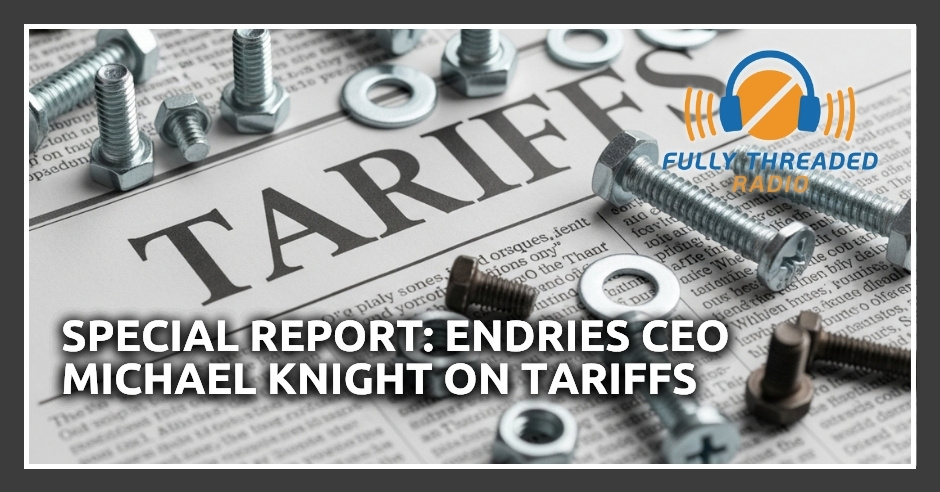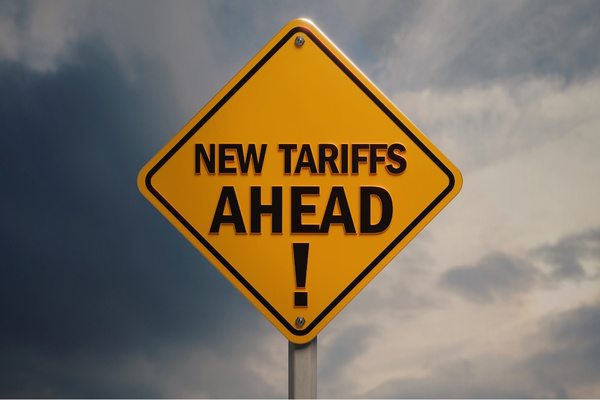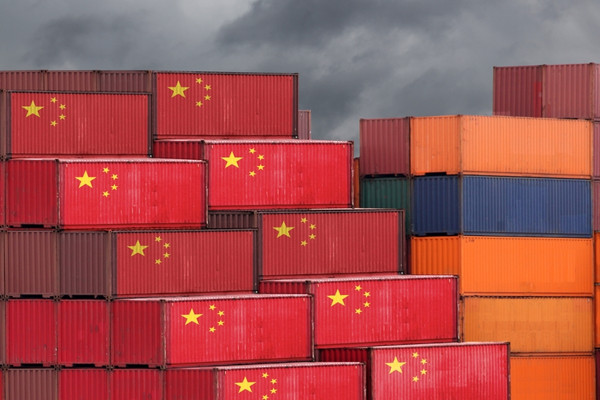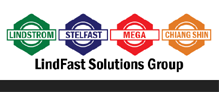
Lots of news with tariffs. This is breaking every day now, as it turns out. Endries CEO Michael Knight reacts to the latest tariffs and shares thoughts on what they mean for the fastener industry. You’ve heard him on the podcast before, probably seen him at various shows, and seen his many posts on LinkedIn. He’s a person who has many insights and an excellent perspective to share with us here. Run time: 21:16
—
Listen to the podcast here
Important Links
- Michael Knight on LinkedIn
- Endries International
- FTR@FullyThreaded.com
- Jim Derry in LinkedIn
- Field Fastener
- Gene Simpson on LinkedIn
- Semblex
Special Report: Endries CEO Michael Knight On Tariffs
Everyone. It’s another special edition of the show. Lots of news with tariffs. This is breaking every day now, as it turns out. This is a conversation with Brilliant Wisconsin-based Endries CEO, Michael Knight. You’ve heard him on the show before, probably seen him at various shows, and seen his many posts on LinkedIn. He’s a person who has many insights and an excellent perspective to share with us here. We’ll dive right in.
The title sponsors of Fully Threaded Radio are Brighton-Best International, Goebel Fasteners, and Star Stainless. Fully Threaded is also sponsored by Buckeye Fasteners, BTM Manufacturing, Eurolink Fastener Supply Service, Fastener Technology International, INxSQL Software, Fastener Fair USA, J. Lanfranco, Solution Industries, Volt Industrial Plastics, and Würth Industry USA. Thanks so much for tuning in. If you’ve got tips or ideas for future episodes of the show, our email address is FTR@FullyThreaded.com. We always appreciate the support. Here’s this conversation with Michael Knight.
—
Michael, thanks for talking to me about tariffs. We’ve been talking offline, and we said, “Let’s turn the recorder on.”
Getting Fatigue With Tariffs
Look out. What’s interesting, Eric, is now’s the time to be talking about this because I think that it won’t be long before we are also just completely fatigued about this. We don’t want to talk about it. We don’t want to listen to it. We don’t want to think about it, but in the meantime, obviously, a lot to unpack, but I think the big thing for me is just comprehensively impactful.
This has been in the fastener industry in particular. I think the fastener industry is, in fact, somewhat unique in terms of what we have to deal with because obviously so much of what we do is made out of steel, and so much of what’s going on, at least at this point, centers around steel. It’s layers of tariffs. This is related to section 232, and it’s not just on the Chinese anymore, obviously. Restrictions on 232 are exemptions.
I think every country that we might import steel from or import something made out of steel now has a tariff on it. Of course, our northern neighbors, who export a lot of steel to our domestic manufacturers for fasteners, have a tariff on it. They’ve put a reciprocal tariff on the stuff that we make out of steel, among other things, and send back into Canada. The net result is that the fastener industry is already deeply impacted by this.
In fact, in the middle of March, I started getting hit with this on my imports. It’s not just the tariff. It’s also all of the paperwork and everything else that comes with it. It has exponentially increased the amount of work that we have to do on our imports. I went through an example with a team earlier this week of the new paperwork requirements, data requirements. They’re expecting us to not just identify the country of origin, but also where the metal was smelted, where it was poured.
There’s a whole bunch of new data points that customs wants, but of course, our suppliers aren’t ready to supply. In some cases, frankly, the data is proprietary. It’s not something that a supplier would just voluntarily provide. Of course, we as importers have to figure out how we’re going to receive the data, what we’re going to do with it, and how we’re going to store it so that it can be easily accessed, because we don’t know what we’re going to be called upon to provide.
There’s this notion out there that, let’s say, we’re importing a bolt, and if the cost of that is 60% steel, that theoretically we’d only have to pay a tariff on the 60% instead of the 100% price that we’re paying for that bolt. Customers have heard that, and they’re saying, “Even if you’re going to pass this thing through, I don’t want to pay a tariff on 100% of your buy price. I want to pay for it just on the steel.”
We’re nowhere near ready to do that. The suppliers, even if they’re willing to provide that data, aren’t ready to do that. By the way, at the border, customs isn’t ready to handle that. That’s the problem. The big challenge with a lot of this is we’re treating it like a light switch. We make this proclamation by we, I mean, our federal government, that starting tomorrow, there’s going to be a 25% tariff on all cars that come in. There’s a lot of stuff that has to go into place before we can actually implement that. We’re expecting like 24-hour implementation on this stuff, and it’s that’s just not practical.
Long story short here, the faster industry is really up against this, and our customer base, understandably, they’re confused, they’re concerned, and it goes beyond just fasteners because so many of our customers, what they’re building involves a lot of metal. Whether it’s a generator or a snowblower, obviously, the housings of these things have a lot of metal involved. They’re having to deal with the tariff impact of that, etc. I’ve been working a long time in my entire career, and I’ve never experienced anything even remotely this nutty.
The fastener industry is up against tariffs, and the customers are understandably confused and concerned. It also goes beyond just fasteners and into other metals as well. Share on XWe were trying to schedule a meeting, and you were going through the calendar, and you pointed out, “Every Friday afternoon now is chewed up with the tariff meeting.” That’s how you end your week these days.
How Tariffs Are Affecting Chinese Suppliers
Most mornings, that’s how we start it because it’s changing so quickly. Fortunately, it’s a weird thing to say, but the first Trump administration forced us with the Section 301 tariffs against China to put some systemic things in place on how to do this in terms of a pass-through. My preference, frankly, is to handle the tariffs as a pass-through because they are binary. At the moment, they’re turned on.
It’s a real cost impact to me that I have to deal with. At some point in time, I have to believe they’ll be turned off. The faster that I can disconnect from the tariffs, because they’re no longer a cost impact, therefore decouple tariffs from my customer, the better. That’s the other part of this, Eric. The big question that I think everybody’s getting right now is “How are we going to handle this?” If you think about this for Andres’ business, I’m the importer of record for a lot.
I’m paying the tariff when I get the part in. I know exactly what that tariff is. My preferred method of dealing with it, because by the way, it’s too big for any of us to eat. That’s the other thing people are struggling to make peace with is this immediate notion that the channel just is going to have to absorb this.
I don’t know if you’ve been following the news about what Walmart is doing, for instance, Walmart’s basically telling their foreign suppliers, “Don’t bother. We’re not paying the tariff. You have to reduce your price accordingly.” The Chinese suppliers, in particular, are saying, “I cannot do it. Not happening.” There’s not enough margin in this business for us with in this particular instance, Walmart, to eat it.
It’s true in my business as well, especially if parts are coming out of China. The size of these tariffs means that this is not just going to get absorbed. It’s got to get passed through ultimately to the end customer. That’s very traumatic. If you think again about our business, when they import a record, I can do that very transparently. That’s my preferred method of doing it. That said, not all customers can take it.

In essence, it’s a tariff surcharge and line item on an invoice, so we’re having to work that out. With that same customer, I may also be supplying parts where I’m not the importer of record that the parts are imported. In those instances, my cost on that part is going to have the tariff baked into the cost. It’s my least favorite way because it’s a lot less transparent, and it’s a lot more difficult to strip it out. The second I get a cost reduction from my source, I can pass that.
I can implement that with my end customer. It’s murky, and that doesn’t happen as quickly as flipping the switch on the surcharge. The third instance is I’m sourcing something locally, but it too has had an impact on cost because of this Canadian steel surcharge, or rather, tariff. I bet this is better than I do. Many of our domestic suppliers of fasteners rely on Canadian steel, and some very heavily.
That shows up as a cost increase. I may be talking to customers about all three situations based on the basket of parts that I’m supporting them on. It’s a ton of data. The takeaway here is, at least for us, it’s a very part-number and customer-specific strategy on how to deal with this. Of course, we’re not the only ones that are supplying parts that are affected by this to the customer.
The customer has to do this on a much larger scale. Just to underline it, for the things that I’m an importer of record of, we’ve identified 110,000 part numbers that are now affected by tariffs. Of course, every morning we wake up, there are new tariffs and more part numbers. You imagine the amount of data you have to chew through.
How Tariffs Are Causing Supply Chain Disruptions
Incredible. We’re ensconced here in the fastener industry. You were saying earlier that it’s hitting the fastener world, but it might not just be our imagination. I don’t know if you caught it last week, front page of the business section of the Wall Street Journal. It had a headline, Tariffs on screws are already hitting their manufacturing. Jim Derry with Field Fastener was quoted in there, and he was pointing out exactly what you were saying. “We’re not paying it. They’re not paying it. Who’s going to pay it?” I think ultimately there’s going to be a lot of finger-pointing, and can anyone say supply chain disruptions?
If you get moved beyond just the tariff and you start looking at second and third-order effects, I think you’re right. What’s going to end up happening? We’re already seeing it. As people scramble and try to reconfigure their supply chains. Lead times are pushing out, and container costs are going up. On top of everything else, apparently, we’re now going to start charging at the port.
I think it’s a hundred and/or $1.5 million if the ship was built by China and/or is owned and operated by a Chinese company. The math I saw on this adds another $200 or $300 to the cost per container. Obviously, the transportation costs for containers have been swinging pretty wildly through 2024, and at points, almost to the level they were during the worst of the supply chain crisis. That’s not good news because again, it’s pushing up the cost of freight.
By the way, this was really interesting. The fact is that the Chinese now pretty much dominate the shipping manufacturing industry. I want to say, this is just off the top of my head, so I could be getting this wrong, but they make like 8,700 freighters a year, and we make domestically like 300. If our objective in this is to get people to buy US ships, how long is it going to take before we can scale up to actually offset Chinese supply? Therein lies a thing we’re all wrestling with, which is trying to understand the objectives, which I’ll just tell you, I think many of them are extremely important.

I think what we’re trying to accomplish here, conceptually, is tough, but it’s really important. As the president has said, it’s not going to happen without some pain. There’s a level of realism about what it takes to implement this stuff that I’m confused about. There’s no way that all this manufacturing is going to come back to the US overnight. Let’s be honest, over the course of 50 years, it’s shifted. I want to talk for a minute about incentives versus tariffs, because I think that’s relevant here.
How Incentives Could Solve The Tariffs Issue
I saw your LinkedIn post on that subject, Michael, and I’d like you to talk on that. I think you’re hitting at a really great point right here. I’d like to stick on it for just a second before you move on to that. In that same article from the Wall Street Journal, Gene Simpson of Semblex was making a similar point.
He said, “The production capacity we need doesn’t exist here in the US to fill the gap.” My question to you is, assuming that our intentions with all this or our objectives with these tariffs are, as you said, you’ve got to face the piper eventually. Do you think that better communication would help this situation out? Do you think it’s as simple as that? If we just understood what was happening, that it would remove some of the chaos?
It would help. Honestly, I think I have a pretty good handle on what’s happening because I don’t have a choice. I probably spend 3 or 4 hours of my day these days that are related to tariffs and these second-order effects. Eric, here’s the thing. If we all had a perfect understanding, we’d be scared. Maybe I should say more scared. You need the understanding to figure out how to navigate this.
I’ll tell you right now, and I’ve said this out loud before, too, is I don’t see any safe harbors. Back on this point of how quickly it’s going to take to reshore, the fact of the matter is, and I think this might even have been talked about in the same Wall Street Journal article, we’re already tight on labor. We bring all this manufacturing back. We don’t have the people to support it just yet, and maybe ever. That’s a problem.
There’s also the matter of the expense of this, whether it’s expanding. You’re already here, it’s expanding capacity, or you’re not here and you’re going to come in. I’ll tell you, we’ve been doing a lot of things in terms of new DCs. I’ve got a new DC I just set up down in Texas. I finished one about a year ago in the Chicago area. Just moving into an existing, it’s already constructed building, moving an operation out of one area into a new building.
That’s a six-month process. If you have to build it, add another 18 months. I don’t understand the math. This is something we’re going to have to deal with. You add to that, and this will get me into what you were talking about, the difference between the carrot and stick approach. The issue with tariffs is that they can be flipped on and off very quickly, as we have all now seen. If the tariff is the motivation to add capacity in the US, and you know that motivation could evaporate literally overnight, how willing are you to step up on a long-term capital commitment to add that capacity?
I fear that there’s just a real reluctance to take action on this because there’s uncertainty about how long the tariff is going to last, which gets me to what I think is probably the most important consideration here, which is the thing I like about incentives, whether they’re tax abatement. Incentives can come in lots of different ways. Incentives tend to be passed into law. They’re more predictable, more dependable.
We all need to be prepared for tariffs. This is how it will be for the rest of this year and into next year until some progress has been made. Share on XI think in the long run, they enable companies to make these long-term big bets more easily. The fact of the matter is, it was the incentives that other countries, especially Asian countries, offered our US manufacturing companies to relocate to Asia. This is back in the ‘70s, ‘80s, and ‘90s that created that shift.
I think historically, we have a perfect example of how effective incentives can be to move things, to reorganize the global supply chain, because that’s what happened back then. That was the first massive restructuring in the global supply chain. In a way, actually, if you think about it, it was the start of the globalization of the supply chain. It was all driven by incentives. Admittedly, that’s a long time scale.
This has been ongoing now for over 50 years, but initially, it was probably about ten years before that really took hold. I think one of the hallmarks of President Trump is that he’s action-oriented and he’s impatient. Actually, I share some of those traits, so I can understand that. Ten years these days, that’s a lifetime. We don’t have ten years for that to happen. Here we are.
How The Tariffs Issue Would Unfold
Appreciate your insights, Michael. It’s always amazing to talk to you because you have great ones and you’re always willing to share them. Let me wind up with this. I don’t want to put you on the hot seat here, not to prognosticate, but where are you putting your money on this? How does it unfold?
I think where I put my money, frankly, is that this is going to be around for a long time. Again, because some of the things we’re trying to accomplish here are long overdue and really important. The semiconductor industry, for instance, is strategically important to our future. Something different has to happen there. At the same time, I don’t think we’re going to be buying made in the USA clothing or shoes anytime soon.
I think that stuff just doesn’t exist, and we all need clothing. I tend to take the president at his word. I think it’s if you go back in time, he’s been very consistent about his feelings on trade and on tariffs in particular. I think we all need to be prepared for this. This is how it’s going to be for the rest of this year into next year, until some progress has been made on these goals that he’s set for these actions. I’m fully buckled up, Eric.
We’ll take that. I’ll look forward to talking with you about it down the road, then. It looks like we’ll have some time to do that.
I appreciate the discussion. Thank you.
Thanks, Michael.



![[GC2610] Solution_FCH Banner_[220x100] copy](https://news.fastenersclearinghouse.com/wp-content/uploads/2025/09/banner_solutionind.jpg)

